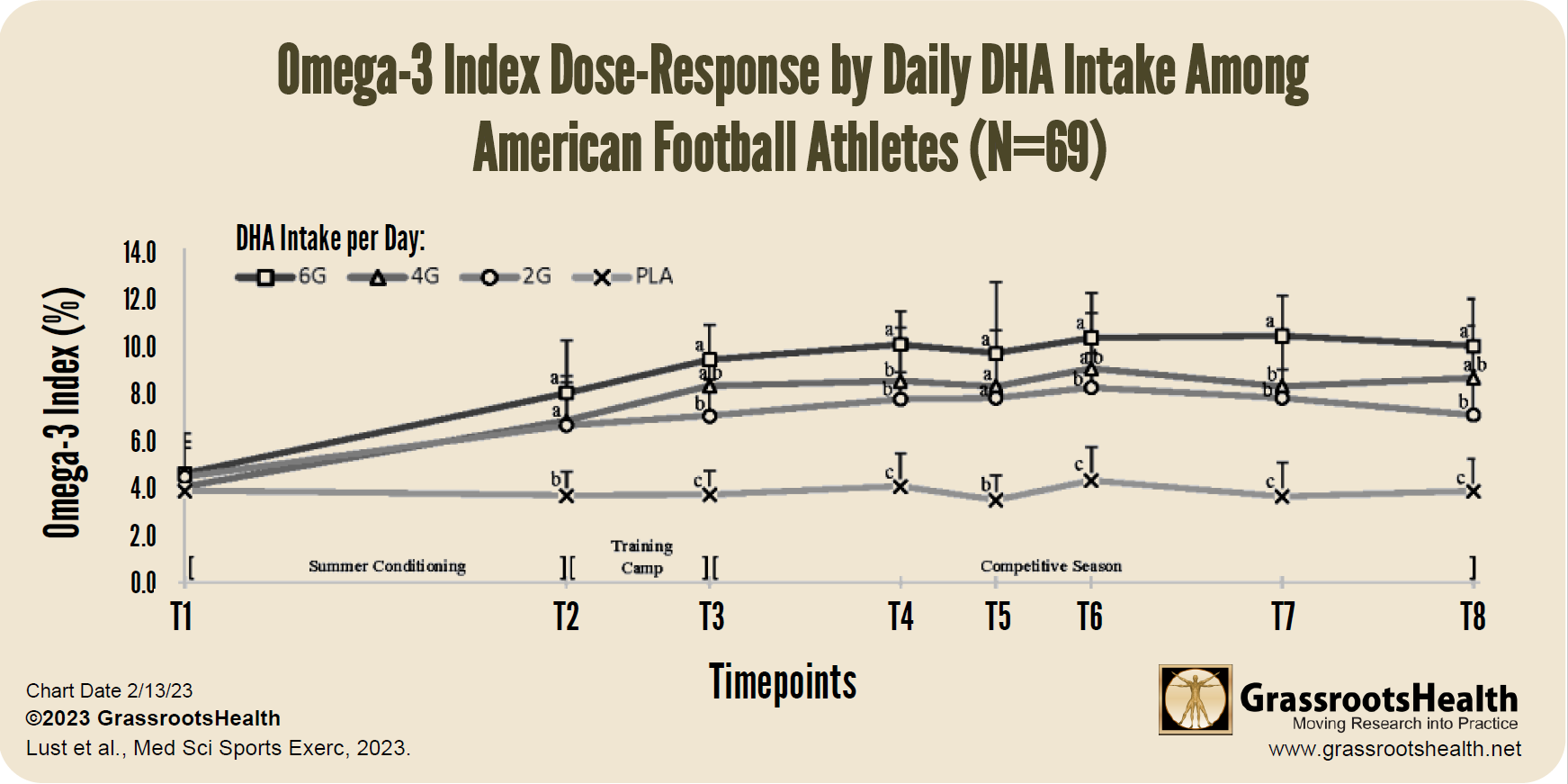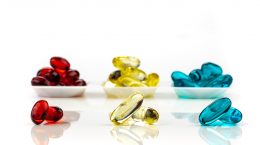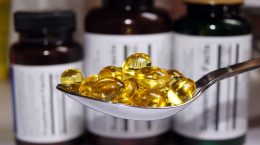Published on February 14, 2023
An RCT involving American Football players illustrates the Omega-3 Index dose response over a 27 week period, with higher doses required to maintain optimal omega-3 levels compared to others
Key Points
- American football players have a higher risk of brain inflammation from head trauma, as well as hypertension and cardiovascular disease, indicating a greater need for omega-3 fatty acids
- A recent study found that players supplementing with 6 g/day of DHA achieved the highest Omega-3 Index of all players, reaching an index greater than 8% at twice the rate as those taking 4 g/day (8 weeks vs. 15 weeks); players taking 2 g/day of DHA were not able to maintain an average Omega-3 Index of 8% or higher during the time of the study
- A GrassrootsHealth analysis showed that ~1,300 mg/day of EPA+DHA was needed for 50% of the population to achieve an Omega-3 Index of 8%; approximately 1,900 mg/day of EPA+DHA was needed for 90% of the population to achieve an Omega-3 Index of 8% – this was not enough for the athletes in this recent study!

Research has demonstrated a neuroprotective effect of the omega-3 fatty acid DHA among athletes prone to head trauma, with studies showing lower levels of brain inflammation markers related to brain injury for those supplementing with DHA. Studies among American football players have also indicated a higher risk of hypertension and cardiovascular disease for these athletes; omega-3s have many demonstrated protective effects on cardiovascular health.
The Omega-3 Index, which records the percentage concentration of omega-3s EPA and DHA in red blood cells, is often used as an indicator of overall heart health. Research shows an Omega-3 Index between 8% and 12% is associated with lower risk of death from cardiovascular disease, versus an index less than 4%, with some studies showing a 10-fold higher risk of death among individuals with a low Omega-3 Index compared to those with a high index.
How Much Omega-3s Should Athletes Take, and For How Long?
A randomized, double-blind, placebo controlled trial by Lust et al. evaluated the effect of omega-3 supplementation on the Omega-3 Index of American football players over the course of a playing season. The authors hypothesized that these athletes would require greater quantities of omega-3 fatty acids in order to achieve the same Omega-3 Index compared to non-athletes with a lower body mass, due to the effects of body weight and physical activity on the Omega-3 dose-response.
In this study, 69 players were randomly assigned to either receive an algal oil supplement with DHA doses of 2 g/day, 4 g/day, or 6 g/day, or a placebo. The Omega-3 Index was measured 8 different times over a 27 week period.
The study found that players supplementing with 6 g/day of DHA achieved the highest Omega-3 Index of all players, reaching an index greater than 8% at twice the rate as those taking 4 g/day (8 weeks vs. 15 weeks). Players taking 2 g/day of DHA were not able to maintain an average Omega-3 Index of 8% or higher during the time of the study. The Omega-3 Index of all players supplementing with DHA reached a steady state around 15 weeks of supplementation, indicating the importance of allowing enough time for full saturation to occur (an essential factor to consider, especially when evaluating studies on omega-3 dose-response and potential health effects).
Using the Omega-3 Index as an indicator for cardiovascular disease risk (high risk, < 4%; intermediate risk, 4-8%; and low risk, >8%), only players taking at least 4 g/day of DHA achieved levels representing low CVD risk. The omega-6 to omega-3 ratio, another indicator of cardiovascular disease risk, was also reduced in a dose-response manner among players.
Majority of GrassrootsHealth Participants Achieved an Omega-3 Index of 8% or Higher with 1,900 mg/day – This Amount was NOT Enough for These Athletes!
In November of 2019, GrassrootsHealth published a paper that assessed the EPA+DHA intake requirement to achieve an Omega-3 Index of 8% or higher. This original analysis found that among the 265 participants who reported no fatty fish intake (to ensure no major sources of EPA+DHA input beyond supplements), ~1,300 mg/day of EPA+DHA was needed for 50% of the population to achieve an Omega-3 Index of 8%. Approximately 1,900 mg/day of EPA+DHA was needed for 90% of the population to achieve an Omega-3 Index of 8%.
We ran this analysis again, with almost twice as many participants, and found the EXACT SAME results: ~1,300 mg/day of EPA+DHA was needed for 50% of the population and ~1,900 mg/day was needed for 90% of the population to achieve and Omega-3 Index of 8%.
However, the athletes in the study above were NOT able to maintain an Omega-3 Index of 8% or higher with an intake of 2,000 mg of DHA per day… indicating such athletes require a higher intake of omega-3’s DHA and EPA than other populations.
The Importance of Testing Your Omega-3 Index
It is important to point out that these intake amounts are averages and there is a large amount of variability in the omega-3 status for different people with the same intake amount (this topic will be covered in more detail shortly). For example, our initial analysis showed that the range of response with 1000 mg of EPA+DHA per day was 5.7% to 10.2%. This large amount of variability is similar to what we have observed for vitamin D. Therefore, we recommend that individuals measure their Omega-3 Index and determine a personalized dose. Check out our Omega-3 calculator to help you determine the estimated dose needed for you to reach your desired Omega-3 Index.
Is Your Omega-3 Index Less than 4%?
With the US having an average Omega-3 Index level of around 4%, the chances are pretty high that your Omega-3 Index is in the high CVD risk category! There is no way to know for sure if you are getting enough omega-3s unless you test your levels.
Include Your Omega-3 Index and Omega Ratios with Your Vitamin D Test
 Having and maintaining healthy vitamin D levels and other nutrient levels can help improve your health now and for your future. Choose which additional nutrients to measure, such as your omega-3s and essential minerals including magnesium and zinc, by creating your custom home test kit today. Take steps to improve the status of each of these measurements to benefit your overall health. With measurement you can then determine how much is needed and steps to achieve your goals. You can also track your own intakes, symptoms and results to see what works best for YOU.
Having and maintaining healthy vitamin D levels and other nutrient levels can help improve your health now and for your future. Choose which additional nutrients to measure, such as your omega-3s and essential minerals including magnesium and zinc, by creating your custom home test kit today. Take steps to improve the status of each of these measurements to benefit your overall health. With measurement you can then determine how much is needed and steps to achieve your goals. You can also track your own intakes, symptoms and results to see what works best for YOU.
Enroll in D*action and Test Your Levels Today!






